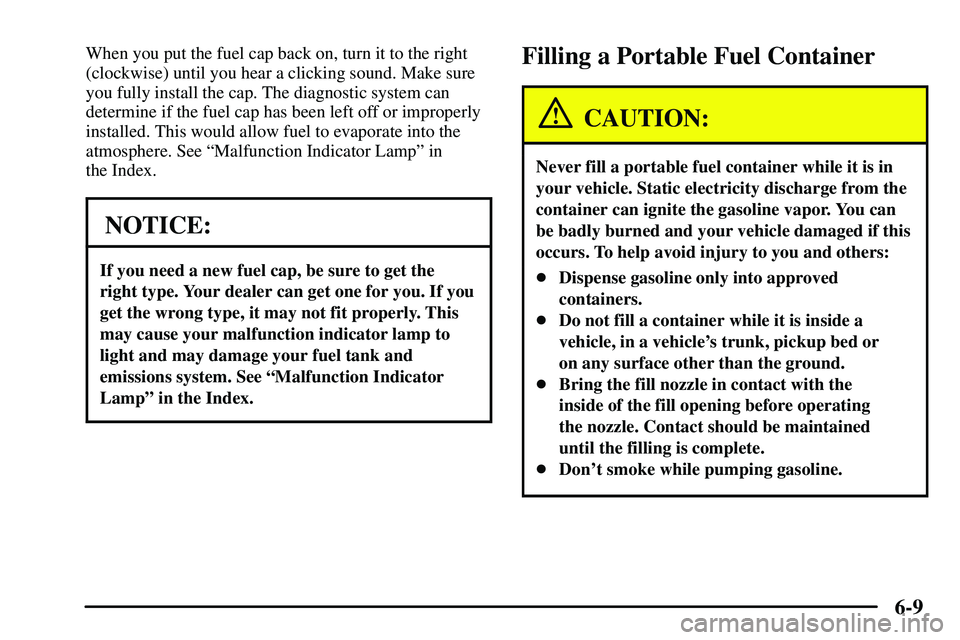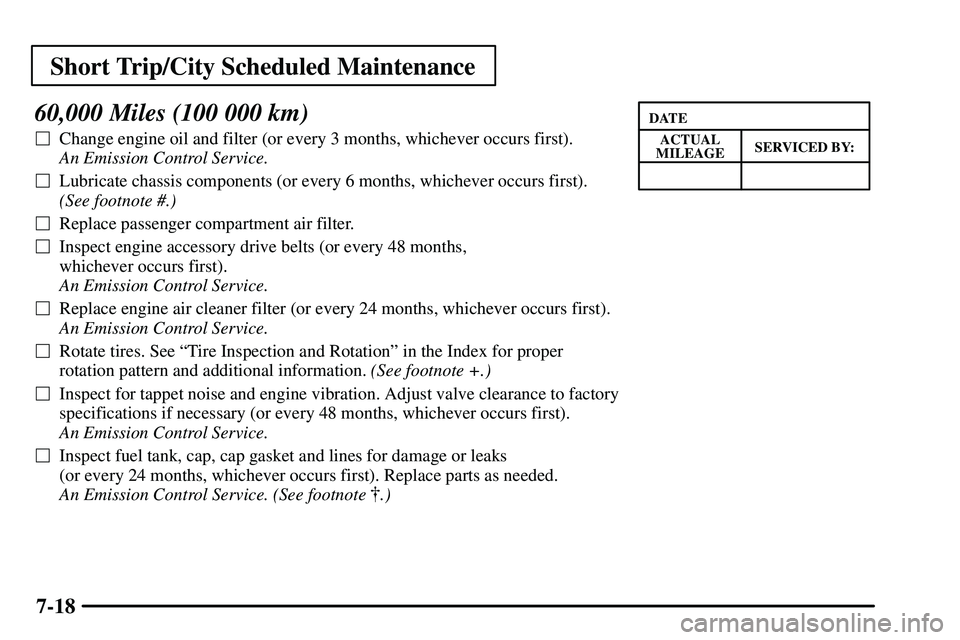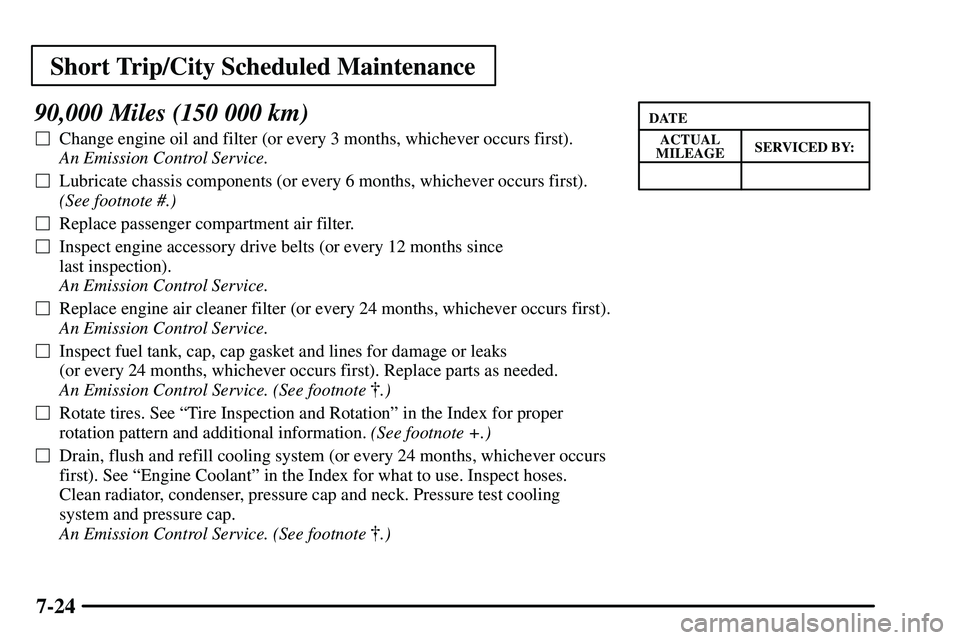Page 253 of 381
6-8
While refueling, hang the fuel cap inside the fuel door.
To remove the fuel cap, turn it slowly to the left
(counterclockwise).
CAUTION:
If you get fuel on yourself and then something
ignites it, you could be badly burned. Fuel can
spray out on you if you open the fuel cap too
quickly. This spray can happen if your tank is
nearly full, and is more likely in hot weather.
Open the fuel cap slowly and wait for any ªhissº
noise to stop. Then unscrew the cap all the way.
Be careful not to spill fuel. Clean fuel from painted
surfaces as soon as possible. See ªCleaning the Outside
of Your Vehicleº in the Index.
Page 254 of 381

6-9
When you put the fuel cap back on, turn it to the right
(clockwise) until you hear a clicking sound. Make sure
you fully install the cap. The diagnostic system can
determine if the fuel cap has been left off or improperly
installed. This would allow fuel to evaporate into the
atmosphere. See ªMalfunction Indicator Lampº in
the Index.
NOTICE:
If you need a new fuel cap, be sure to get the
right type. Your dealer can get one for you. If you
get the wrong type, it may not fit properly. This
may cause your malfunction indicator lamp to
light and may damage your fuel tank and
emissions system. See ªMalfunction Indicator
Lampº in the Index.
Filling a Portable Fuel Container
CAUTION:
Never fill a portable fuel container while it is in
your vehicle. Static electricity discharge from the
container can ignite the gasoline vapor. You can
be badly burned and your vehicle damaged if this
occurs. To help avoid injury to you and others:
�Dispense gasoline only into approved
containers.
�Do not fill a container while it is inside a
vehicle, in a vehicle's trunk, pickup bed or
on any surface other than the ground.
�Bring the fill nozzle in contact with the
inside of the fill opening before operating
the nozzle. Contact should be maintained
until the filling is complete.
�Don't smoke while pumping gasoline.
Page 321 of 381

6-76
Replacement Bulbs
Lamps Bulb Number
Headlamp High
-/Low-Beam 9003. . . . . . . . . . . . . . .
Front Turn Signal 1157NA. . . . . . . . . . . . . . . . . . . . . .
Stoplamps/Taillamps 7443. . . . . . . . . . . . . . . . . . . . .
Back
-Up Lamps 7440. . . . . . . . . . . . . . . . . . . . . . . . .
Rear Turn Signal 7440. . . . . . . . . . . . . . . . . . . . . . . .
CHMSL 921. . . . . . . . . . . . . . . . . . . . . . . . . . . . . . . .
Capacities and Specifications
The following approximate capacities are given in
English and metric conversions.
Cooling System
1.8L Engine (Code 8) 6.9 quarts (6.5 L). . . . . . . . .
1.8L H.O. Engine (Code L) 7.1 quarts (6.7 L). . . . Engine Oil with Filter
1.8L Engine (Code 8) 3.9 quarts (3.7 L). . . . . . . . .
1.8L Engine (Code L) 4.8 quarts (4.4 L). . . . . . . . .
Fuel Tank
With AWD 12.0 gallons (45.0 L). . . . . . . . . . . . . . . .
Without AWD 13.0 gallons (49.0 L). . . . . . . . . . . . .
Automatic Transaxle
1.8L Engine (Code 8) 3.3 quarts (3.1 L). . . . . . . . .
1.8L Engine (Code 8)
with AWD 3.1 quarts (2.9 L). . . . . . . . . . . . . . . . . .
Manual Transaxle
Five-Speed 2.0 quarts (1.9 L). . . . . . . . . . . . . . . . .
Six
-Speed 2.4 quarts (2.3 L). . . . . . . . . . . . . . . . . .
Rear Differential0.5 quarts (0.5 L) . . . . . . . . . . . . .
Transfer Case0.8 quarts (0.8 L) . . . . . . . . . . . . . . . .
All capacities are approximate. When adding, be sure to
fill to the approximate level, as recommended in this
manual. See ªRecommended Fluids and Lubricantsº
in the Index.
Page 328 of 381

Scheduled Maintenance
7-5
Short Trip/City Definition
Follow the Short Trip/City Scheduled Maintenance if
any one of these conditions is true for your vehicle:
�Most trips are less than 5 miles (8 km). This is
particularly important when outside temperatures are
below freezing.
�Most trips include extensive idling (such as frequent
driving in stop
-and-go traffic).
�You frequently tow a trailer or use a carrier on top of
your vehicle.
�If the vehicle is used for delivery service, police, taxi
or other commercial application.
One of the reasons you should follow this schedule
if you operate your vehicle under any of these conditions
is that these conditions cause engine oil to break
down sooner.
Short Trip/City Intervals
Every 3,000 Miles (5 000 km): Engine Oil and Filter
Change (or 3 months, whichever occurs first).
Every 6,000 Miles (10 000 km): Chassis Lubrication
(or 6 months, whichever occurs first). Tire Rotation.
Engine Air Cleaner Filter Inspection, if driving in
dusty conditions.
Every 15,000 Miles (25 000 km): Passenger
Compartment Air Filter Replacement. Transfer Case
Fluid Change (when trailer towing). Rear Differential
Fluid Change (when trailer towing).
Every 30,000 Miles (50 000 km): Engine Air Cleaner
Filter Replacement. Fuel Tank, Cap, Cap Gasket and
Lines Inspection (or every 24 months, whichever
occurs first). Automatic Transaxle Check. Manual
Transaxle Fluid Change (severe conditions only)
(or every 24 months, whichever occurs first).
Cooling System Service (or every 24 months,
whichever occurs first).
Page 330 of 381

Scheduled Maintenance
7-7
Long Trip/Highway Intervals
Every 7,500 Miles (12 500 km): Engine Oil and Filter
Change (or every 12 months, whichever occurs first).
Chassis Lubrication (or every 12 months, whichever
occurs first). Tire Rotation.
Every 30,000 Miles (50 000 km): Engine Air Cleaner
Filter Replacement. Fuel Tank, Cap, Cap Gasket and
Lines Inspection (or every 24 months, whichever
occurs first). Automatic Transaxle Fluid Check.
Manual Transaxle Fluid Change (severe conditions
only) (or every 24 months, whichever occurs first).
Cooling System Service (or every 24 months,
whichever occurs first).
Long Trip/Highway Intervals
Every 60,000 Miles (100 000 km): Automatic
Transaxle Fluid Change (severe conditions only).
Valve Clearance Inspection, adjust if necessary
(or every 48 months, whichever occurs first).
At 60,000 Miles (100 000 km) (or 48 Months,
Whichever Occurs First)
-- Then Every
15,000 Miles (25 000 km) (or 12 Months,
Whichever Occurs First): Engine Accessory
Drive Belt Inspection.
Every 120,000 Miles (200 000 km): Spark Plug
Replacement.
These intervals only summarize maintenance services.
Be sure to follow the complete scheduled maintenance
on the following pages.
Page 336 of 381

Short Trip/City Scheduled Maintenance
7-13
30,000 Miles (50 000 km)
�Change engine oil and filter (or every 3 months, whichever occurs first).
An Emission Control Service.
�Lubricate chassis components (or every 6 months, whichever occurs first).
(See footnote #.)
�Replace passenger compartment air filter.
�Replace engine air cleaner filter (or every 24 months, whichever occurs first).
An Emission Control Service.
�Inspect fuel tank, cap, cap gasket and lines for damage or leaks
(or every 24 months, whichever occurs first). Replace parts as needed.
An Emission Control Service. (See footnote �.)
�Rotate tires. See ªTire Inspection and Rotationº in the Index for proper
rotation pattern and additional information. (See footnote +.)
�Drain, flush and refill cooling system (or every 24 months, whichever occurs
first). See ªEngine Coolantº in the Index for what to use. Inspect hoses.
Clean radiator, condenser, pressure cap and neck. Pressure test cooling
system and pressure cap.
An Emission Control Service. (See footnote �.)
�Change manual transaxle fluid every 30,000 miles (50 000 km) only if your
vehicle is used to tow a trailer.
�Check automatic transaxle fluid.
�Change transfer case fluid when doing frequent trailer towing.
�Change rear differential fluid when doing frequent trailer towing.ACTUAL
SERVICED BY:MILEAGE
DATE
Page 341 of 381

Short Trip/City Scheduled Maintenance
7-18
60,000 Miles (100 000 km)
�Change engine oil and filter (or every 3 months, whichever occurs first).
An Emission Control Service.
�Lubricate chassis components (or every 6 months, whichever occurs first).
(See footnote #.)
�Replace passenger compartment air filter.
�Inspect engine accessory drive belts (or every 48 months,
whichever occurs first).
An Emission Control Service.
�Replace engine air cleaner filter (or every 24 months, whichever occurs first).
An Emission Control Service.
�Rotate tires. See ªTire Inspection and Rotationº in the Index for proper
rotation pattern and additional information. (See footnote +.)
�Inspect for tappet noise and engine vibration. Adjust valve clearance to factory
specifications if necessary (or every 48 months, whichever occurs first).
An Emission Control Service.
�Inspect fuel tank, cap, cap gasket and lines for damage or leaks
(or every 24 months, whichever occurs first). Replace parts as needed.
An Emission Control Service. (See footnote �.)ACTUAL
SERVICED BY:MILEAGE
DATE
Page 347 of 381

Short Trip/City Scheduled Maintenance
7-24
90,000 Miles (150 000 km)
�Change engine oil and filter (or every 3 months, whichever occurs first).
An Emission Control Service.
�Lubricate chassis components (or every 6 months, whichever occurs first).
(See footnote #.)
�Replace passenger compartment air filter.
�Inspect engine accessory drive belts (or every 12 months since
last inspection).
An Emission Control Service.
�Replace engine air cleaner filter (or every 24 months, whichever occurs first).
An Emission Control Service.
�Inspect fuel tank, cap, cap gasket and lines for damage or leaks
(or every 24 months, whichever occurs first). Replace parts as needed.
An Emission Control Service. (See footnote �.)
�Rotate tires. See ªTire Inspection and Rotationº in the Index for proper
rotation pattern and additional information. (See footnote +.)
�Drain, flush and refill cooling system (or every 24 months, whichever occurs
first). See ªEngine Coolantº in the Index for what to use. Inspect hoses.
Clean radiator, condenser, pressure cap and neck. Pressure test cooling
system and pressure cap.
An Emission Control Service. (See footnote �.)ACTUAL
SERVICED BY:MILEAGE
DATE